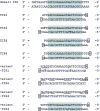Crystallization of and selenomethionine phasing strategy for a SETMAR-DNA complex
- PMID: 27599863
- PMCID: PMC5012212
- DOI: 10.1107/S2053230X16012723
Crystallization of and selenomethionine phasing strategy for a SETMAR-DNA complex
Abstract
Transposable elements have played a critical role in the creation of new genes in all higher eukaryotes, including humans. Although the chimeric fusion protein SETMAR is no longer active as a transposase, it contains both the DNA-binding domain (DBD) and catalytic domain of the Hsmar1 transposase. The amino-acid sequence of the DBD has been virtually unchanged in 50 million years and, as a consequence, SETMAR retains its sequence-specific binding to the ancestral Hsmar1 terminal inverted repeat (TIR) sequence. Thus, the DNA-binding activity of SETMAR is likely to have an important biological function. To determine the structural basis for the recognition of TIR DNA by SETMAR, the design of TIR-containing oligonucleotides and SETMAR DBD variants, crystallization of DBD-DNA complexes, phasing strategies and initial phasing experiments are reported here. An unexpected finding was that oligonucleotides containing two BrdUs in place of thymidines produced better quality crystals in complex with SETMAR than their natural counterparts.
Keywords: DNA-binding domain; Hsmar1; SETMAR; crystallization; terminal inverted repeat; transposable element.
Figures



Similar articles
-
Structural and genome-wide analyses suggest that transposon-derived protein SETMAR alters transcription and splicing.J Biol Chem. 2022 May;298(5):101894. doi: 10.1016/j.jbc.2022.101894. Epub 2022 Apr 1. J Biol Chem. 2022. PMID: 35378129 Free PMC article.
-
Structure, Activity, and Function of SETMAR Protein Lysine Methyltransferase.Life (Basel). 2021 Dec 4;11(12):1342. doi: 10.3390/life11121342. Life (Basel). 2021. PMID: 34947873 Free PMC article. Review.
-
The ancient mariner sails again: transposition of the human Hsmar1 element by a reconstructed transposase and activities of the SETMAR protein on transposon ends.Mol Cell Biol. 2007 Jun;27(12):4589-600. doi: 10.1128/MCB.02027-06. Epub 2007 Apr 2. Mol Cell Biol. 2007. PMID: 17403897 Free PMC article.
-
Crystal structure of the human Hsmar1-derived transposase domain in the DNA repair enzyme Metnase.Biochemistry. 2010 Jul 13;49(27):5705-13. doi: 10.1021/bi100171x. Biochemistry. 2010. PMID: 20521842
-
Metnase/SETMAR: a domesticated primate transposase that enhances DNA repair, replication, and decatenation.Genetica. 2010 May;138(5):559-66. doi: 10.1007/s10709-010-9452-1. Epub 2010 Mar 23. Genetica. 2010. PMID: 20309721 Free PMC article. Review.
Cited by
-
Structural and genome-wide analyses suggest that transposon-derived protein SETMAR alters transcription and splicing.J Biol Chem. 2022 May;298(5):101894. doi: 10.1016/j.jbc.2022.101894. Epub 2022 Apr 1. J Biol Chem. 2022. PMID: 35378129 Free PMC article.
-
Structure, Activity, and Function of SETMAR Protein Lysine Methyltransferase.Life (Basel). 2021 Dec 4;11(12):1342. doi: 10.3390/life11121342. Life (Basel). 2021. PMID: 34947873 Free PMC article. Review.
References
-
- Adams, P. D. et al. (2010). Acta Cryst. D66, 213–221. - PubMed
MeSH terms
Substances
Grants and funding
LinkOut - more resources
Full Text Sources
Other Literature Sources

